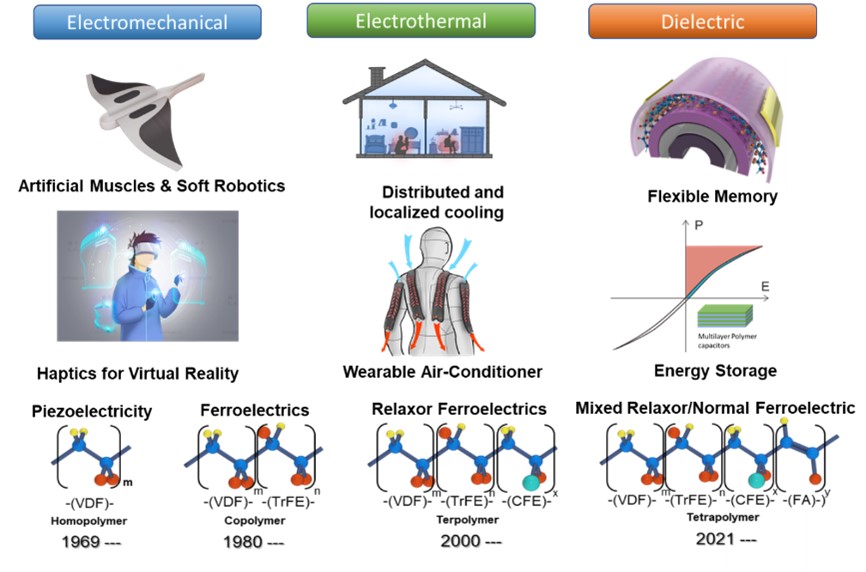Prof. Xiaoshi Qian published a review paper on the field of ferroelectric polymers published in Science
On May 12th, Professor Xiaoshi Qian from the Interdisciplinary Research Center for Engineering Science at the School of Mechanical Engineering of Shanghai Jiao Tong University published a paper entitled "Fluoropolymer Ferroelectrics: Multifunctional Platform for Polar-Structured Energy Conversion" in Science, providing a systematic analysis of the applications of polyvinylidene fluoride (PVDF)-based ferroelectric polymer materials in electromechanical coupling, zero-carbon refrigeration, energy storage, and information storage. This is the first review paper on the field of ferroelectric polymers published by Science after the first comprehensive review of ferroelectric polymers in 1983, 40 years ago.

Polymeric ferroelectric materials have unique characteristics such as high plasticity, ease of manufacturing into complex shapes, mechanical toughness, and spontaneous polarization, which allow for efficient cross-coupling of electrical, mechanical, and thermal energy, resulting in a series of effects such as energy storage, piezoelectric/electrostrictive effect, electrocaloric/thermoelectric effect, ferroelectric storage, etc. These polymer materials, mainly fluoropolymer-based, can be easily processed into thin, robust, and flexible films and fibers that are suitable for portable, miniaturized, and wearable electrically active devices.
In the past two years, significant progress has been made in the development of ferroelectric polymer materials and their derivatives in electromechanical coupling efficiency, electrostrictive strain, electrocaloric refrigeration/heat pump ability, and cycling life, greatly promoting the practical applications and development of this flexible self-polarizing material. In recent years, a series of breakthrough applications have demonstrated that defect control of polarization processes can precisely regulate the efficiency of polymers in different energy conversion processes. A series of breakthrough works have emerged at the level of monomer selection, polymer crystallization, and polarization microstructure morphology. The latest research shows that the piezoelectric and electromechanical coupling coefficients of fluoroalkyl-modified relaxor ferroelectric tetrapolymers have surpassed the most widely used piezoelectric ceramics in the world, PZT piezoelectric ceramics, for the first time. At a low electric field of 50 MV/m, the ferroelectric material achieved an electrostrictive strain of 4%. This progress is expected to promote the rapid development of efficient sensing and touch devices, as well as low-energy electrically driven devices. In a report earlier than the above, electrocaloric polymer materials designed by a similar method showed a large electrocaloric refrigeration effect of over 7.5K under ultra-low electric field and were not easily fatigued, achieving more than a million cooling cycles for the first time. These electrocaloric polymers can provide customized, zero GWP, energy-efficient refrigeration/heat pump solutions, contributing to carbon reduction in the current commercial industries of heat pumps, air conditioning, and refrigeration.
The research progress of ferroelectric polymers, from the initial homopolymers to the current tetrapolymers, has generated a large number of applications that utilize their high-efficiency electromechanical, electrothermal, and dielectric energy conversion effects, which are beneficial to the sustainable development of modern society and provide new directions and opportunities for research in fields such as ferroelectric physics and functional polymers. Current research has found that the design and control strategies of polarity units required for different energy conversion processes are not the same, thus requiring the design of specific ferroelectric polymers for specific application scenarios. Future research needs to further explore the relationship between the molecular structure of ferroelectric polymers and their polarization response, design cross-scale defects to modify/manage polarity structure, reduce the field-induced phase transition potential barrier, and promote a more efficient soft material energy conversion for green, intelligent, and metaverse lifestyles. The mature processes in the polymer industry (multilayer capacitors, fiber fabrics, etc.) can provide convenience for the rapid production and iteration of future advanced functional polymer film devices, which are expected to play a key role in tactile perception and robot applications in the upcoming metaverse and can also serve as solid-state refrigerants for flat or wearable air conditioners, providing wearable, lightweight, and low-energy consumption active cooling and heating control capabilities that other products on the market cannot offer.
Professor Qian has been engaged in research on functional materials and intelligent systems for decades and has participated in the research and development of active materials design and processes of manufacturing, including organics and inorganic oxides. His research interests lie in the fundamentals behind engineering applications in the fields of magneto-electric sensing, electromechanical coupling, dielectric energy storage, and electrocaloric refrigeration. Over the last two years, his research work has garnered publications in highly impacted journals such as Nature and Science.
Paper Link:https://www.science.org/doi/10.1126/science.adg0902



